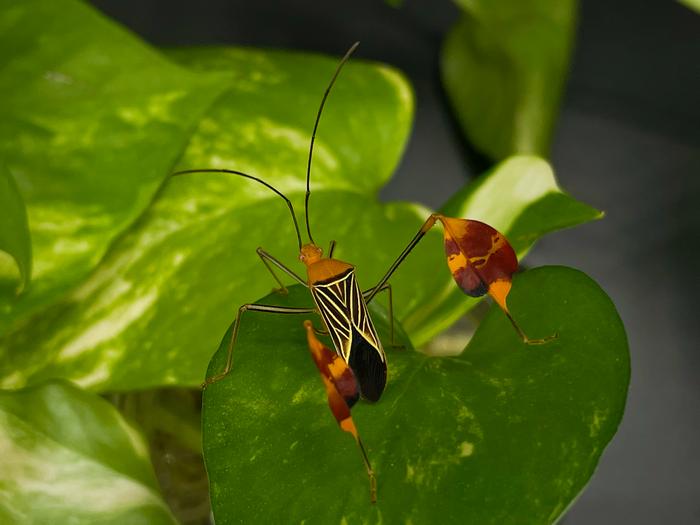In the quaint town of Gamboa, nestled near the Panama Canal, a team of scientists embarked on a unique endeavor: attaching red flags onto the legs of crickets and observing how birds respond to them. These eye-catching flags were borrowed from the matador bug (Anisoscelis alipes), an insect renowned for the colorful adornments on its hind legs. This trait has captivated Smithsonian postdoctoral fellow Ummat Somjee for several years, particularly given the matador bug’s tendency to wave them. The persisting question: Why does it wave its colorful hind legs?

Credit: Ana Endara/STRI
In the quaint town of Gamboa, nestled near the Panama Canal, a team of scientists embarked on a unique endeavor: attaching red flags onto the legs of crickets and observing how birds respond to them. These eye-catching flags were borrowed from the matador bug (Anisoscelis alipes), an insect renowned for the colorful adornments on its hind legs. This trait has captivated Smithsonian postdoctoral fellow Ummat Somjee for several years, particularly given the matador bug’s tendency to wave them. The persisting question: Why does it wave its colorful hind legs?
A previous study, also supervised by Dr. Somjee, suggested a surprising finding that the fancy leg waving was probably not a sexual display. Some of the most obvious and elaborate traits in animals are used to attract mates and these are predominantly expressed in males; think dances of birds of paradise or an elk’s large antlers. Yet, with matador bugs, both males and females showed off their pretty legs. Also, the waving behavior didn’t change whether there were potential mates around or not.
This prompted researchers to explore alternative explanations. Did the waving behavior serve to divert predatory attacks towards their removable hindlegs, increasing their chances of escaping? Alternatively, could the colorful legs be serving as a warning signal to potential predators, alerting them to the bug’s chemical defense or bad flavor? These were the questions asked by Juliette Rubin, currently the Tony Coates Post-Doctoral Fellow at the Smithsonian Tropical Research Institute and lead-author of this study. She had previously spent years understanding how butterflies and moths use elaborate features of their wings to avoid predatory attack, and the matador bugs flags were a mystery ripe for the picking.
This is where the crickets—a popular snack among birds—came into play. Drs. Rubin and Somjee, along with co-authors Jorge Medina and Dr. Jay Falk, observed how predatory birds behaved when presented with true matador bugs and crickets that had matador bug flags attached to their legs. To do so, they used motmots – brilliant, large birds with iridescent feathers, long pendulous tails, and keen eyesight.
Catching the motmots was a whole adventure in and of itself. STRI research assistant Jorge Medina selected a location near the town of Gamboa where the birds were frequently observed and, for several weeks, went into the forest early in the morning to place bird nets.
“We placed the nets in areas of the forest where we saw that the birds moved the most and, when an individual was captured, it was immediately taken to the cages and tested,” said Medina, who spent about a month catching the birds for the experiment. “When the birds were finished with the tests, we released them back in the same area where they were captured.”
The experiment found that predator strikes were not primarily aimed at the hindleg flags, thus discrediting the deflection hypothesis. However, the results supported the chemical defense explanation. Regular crickets were always attacked, but those with flags got fewer hits. Meanwhile, matador bugs were actively avoided, whether they had flags or not, indicating the flags are just one component of their defense strategy.
To support their finding that matador bugs are distasteful prey, the researchers offered crickets and matador bugs to inexperienced chicks – both of which the chicks had never seen before. Again, they found that matador bugs, with or without their flags, seemed to warn these predators to stay away. When the chicks did attack, however, they demonstrated that the bugs were distasteful – shaking their heads and usually refusing to consume another bug. Crickets, on the other hand, were readily attacked and heartily eaten. Their results were published in Behavioral Ecology.
“I was fascinated to see that when we outfitted tasty crickets with the matador bug flags they immediately became less appealing to their bird predators,” said Rubin. “It seems like this warning signal is enough to make the birds cautious, but bugs themselves are so well equipped with ‘don’t eat me!’ signals that even without the flags, experienced birds wouldn’t touch them.”
This study revealed that the flags signal birds that matador bugs aren’t a delectable or safe choice. Yet, these flags collaborate with other aspects of the bug’s appearance to emphasize the message, indicating that they are part of a complex defense strategy that has likely evolved over time to protect these bugs from being eaten by birds.
Although focused on a single insect species, this study represents a significant advancement in deepening our comprehension of the evolution of elaborate traits in nature. These findings enhance our understanding of the reasons behind the presence of brightly colored and unusual physical features in certain animals.
The authors involved in the study represent the Smithsonian Tropical Research Institute, the Florida Museum of Natural History, the University of Florida, the University of Colorado, Boulder, and the University of Texas at Austin.
Headquartered in Panama, the Smithsonian Tropical Research Institute is a unit of the Smithsonian Institution in Washington, DC. The institute furthers the understanding of tropical biodiversity and its importance to human welfare, trains students to conduct research in the tropics and promotes conservation by increasing public awareness of the beauty and importance of tropical ecosystems.
Journal
Behavioral Ecology
DOI
10.1093/beheco/arae019
Article Title
The matador bug’s elaborate flags deter avian predators




